NVIDIA’s GeForce GTX Titan Review, Part 2: Titan's Performance Unveiled
by Ryan Smith & Rahul Garg on February 21, 2013 9:00 AM ESTPower, Temperature, & Noise
Last but certainly not least, we have our obligatory look at power, temperature, and noise. Next to price and performance of course, these are some of the most important aspects of a GPU, due in large part to the impact of noise. All things considered, a loud card is undesirable unless there’s a sufficiently good reason to ignore the noise.
It’s for that reason that GPU manufacturers also seek to keep power usage down, and under normal circumstances there’s a pretty clear relationship between power consumption, heat generated, and the amount of noise the fans will generate to remove that heat. At the same time however this is an area that NVIDIA is focusing on for Titan, as a premium product means they can use premium materials, going above and beyond what more traditional plastic cards can do for noise dampening.
| GeForce GTX Titan Voltages | ||||
| Titan Max Boost | Titan Base | Titan Idle | ||
| 1.1625v | 1.012v | 0.875v | ||
Stopping quickly to take a look at voltages, Titan’s peak stock voltage is at 1.162v, which correlates to its highest speed bin of 992MHz. As the clockspeeds go farther down these voltages drop, to a load low of 0.95v at 744MHz. This ends up being a bit less than the GTX 680 and most other desktop Kepler cards, which go up just a bit higher to 1.175v. Since NVIDIA is classifying 1.175v as an “overvoltage” on Titan, it looks like GK110 isn’t going to be quite as tolerant of voltages as GK104 was.
| GeForce GTX Titan Average Clockspeeds | |||
| Max Boost Clock | 992MHz | ||
| DiRT:S | 992MHz | ||
| Shogun 2 | 966MHz | ||
| Hitman | 992MHz | ||
| Sleeping Dogs | 966MHz | ||
| Crysis | 992MHz | ||
| Far Cry 3 | 979MHz | ||
| Battlefield 3 | 992MHz | ||
| Civilization V | 979MHz | ||
One thing we quickly notice about Titan is that thanks to GPU Boost 2 and the shift from what was primarily a power based boost system to a temperature based boost system is that Titan hits its maximum speed bin far more often and sustains it more often too, especially since there’s no longer a concept of a power target with Titan, and any power limits are based entirely by TDP. Half of our games have an average clockspeed of 992MHz, or in other words never triggered a power or thermal condition that would require Titan to scale back its clockspeed. For the rest of our tests the worst clockspeed was all of 2 bins (26MHz) lower at 966MHz, with this being a mix of hitting both thermal and power limits.
On a side note, it’s worth pointing out that these are well in excess of NVIDIA’s official boost clock for Titan. With Titan boost bins being based almost entirely on temperature, the average boost speed for Titan is going to be more dependent on environment (intake) temperatures than GTX 680 was, so our numbers are almost certainly a bit higher than what one would see in a hotter environment.
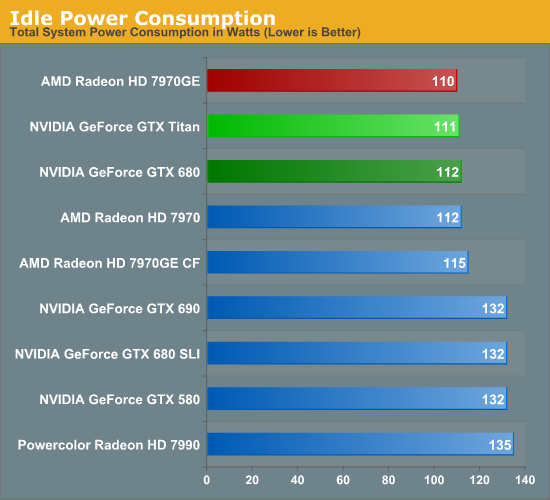
Starting as always with a look at power, there’s nothing particularly out of the ordinary here. AMD and NVIDIA have become very good at managing idle power through power gating and other techniques, and as a result idle power has come down by leaps and bounds over the years. At this point we still typically see some correlation between die size and idle power, but that’s a few watts at best. So at 111W at the wall, Titan is up there with the best cards.
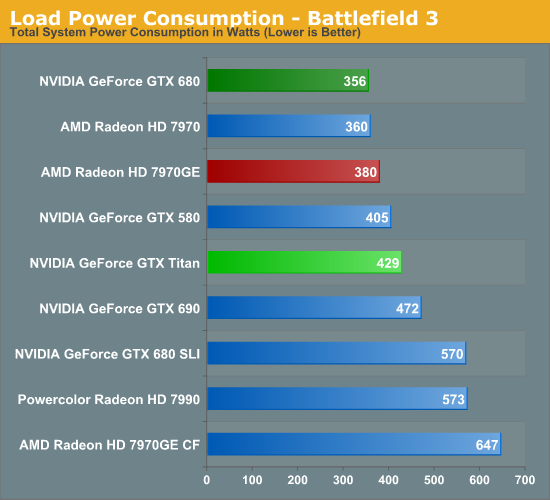
Moving on to our first load power measurement, as we’ve dropped Metro 2033 from our benchmark suite we’ve replaced it with Battlefield 3 as our game of choice for measuring peak gaming power consumption. BF3 is a difficult game to run, but overall it presents a rather typical power profile which of all the games in our benchmark suite makes it one of the best representatives.
In any case, as we can see Titan’s power consumption comes in below all of our multi-GPU configurations, but higher than any other single-GPU card. Titan’s 250W TDP is 55W higher than GTX 680’s 195W TDP, and with a 73W difference at the wall this isn’t too far off. A bit more surprising is that it’s drawing nearly 50W more than our 7970GE at the wall, given the fact that we know the 7970GE usually gets close to its TDP of 250W. At the same time since this is a live game benchmark, there are more factors than just the GPU in play. Generally speaking, the higher a card’s performance here, the harder the rest of the system will have to work to keep said card fed, which further increases power consumption at the wall.
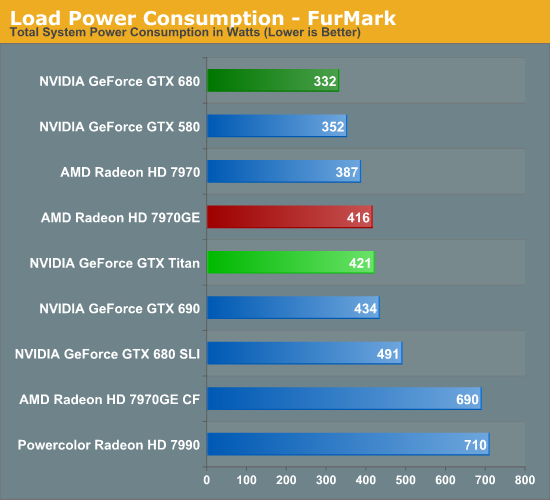
Moving to Furmark our results keep the same order, but the gap between the GTX 680 and Titan widens, while the gap between Titan and the 7970GE narrows. Titan and the 7970GE shouldn’t be too far apart from each other in most situations due to their similar TDPs (even if NVIDIA and AMD TDPs aren’t calculated in quite the same way), so in a pure GPU power consumption scenario this is what we would expect to see.
Titan for its part is the traditional big NVIDIA GPU, and while NVIDIA does what they can to keep it in check, at the end of the day it’s still going to be among the more power hungry cards in our collection. Power consumption itself isn’t generally a problem with these high end cards so long as a system has the means to cool it and doesn’t generate much noise in doing so.
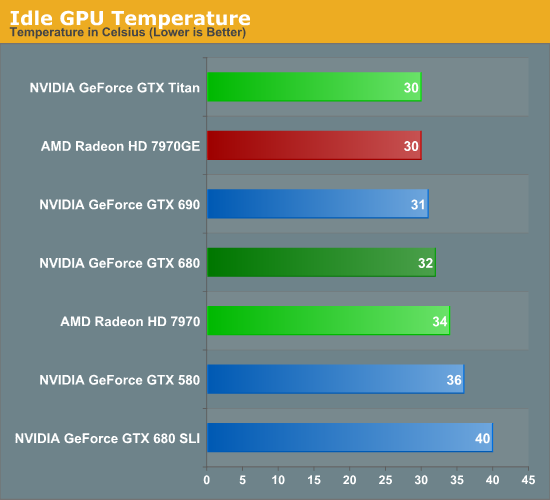
Moving on to temperatures, for a single card idle temperatures should be under 40C for anything with at least a decent cooler. Titan for its part is among the coolest at 30C; its large heatsink combined with its relatively low idle power consumption makes it easy to cool here.
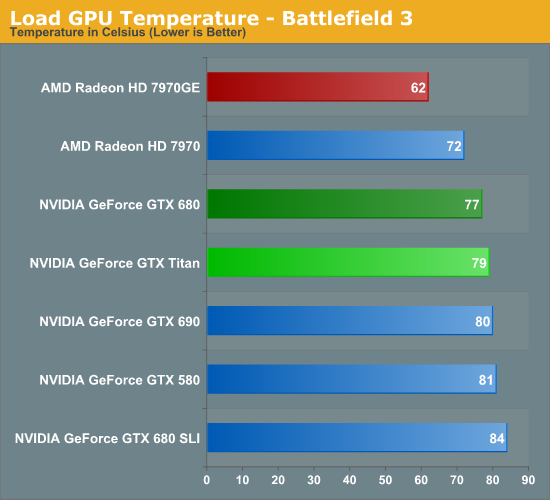
Because Titan’s boost mechanisms are now temperature based, Titan’s temperatures are going to naturally gravitate towards its default temperature target of 80C as the card raises and lowers clockspeeds to maximize performance while keeping temperatures at or under that level. As a result just about any heavy load is going to see Titan within a couple of degrees of 80C, which makes for some very predictable results.
Looking at our other cards, while the various NVIDIA cards are still close in performance the 7970GE ends up being quite a bit cooler due to its open air cooler. This is typical of what we see with good open air coolers, though with NVIDIA’s temperature based boost system I’m left wondering if perhaps those days are numbered. So long as 80C is a safe temperature, there’s little reason not to gravitate towards it with a system like NVIDIA’s, regardless of the cooler used.
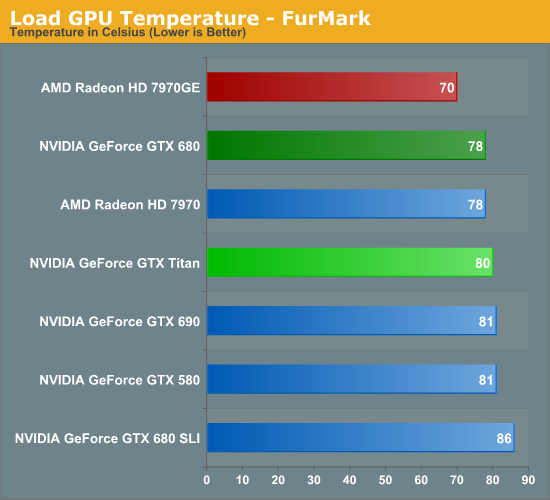
With Furmark we see everything pull closer together as Titan holds fast at 80C while most of the other cards, especially the Radeons, rise in temperature. At this point Titan is clearly cooler than a GTX 680 SLI, 2C warmer than a single GTX 680, and still a good 10C warmer than our 7970GE.

Just as with the GTX 690, one of the things NVIDIA focused on was construction choices and materials to reduce noise generated. So long as you can keep noise down, then for the most part power consumption and temperatures don’t matter.
Simply looking at idle shows that NVIDIA is capable of delivering on their claims. 37.8dB is the quietest actively cooled high-end card we’ve measured yet, besting even the luxury GTX 690, and the also well-constructed GTX 680. Though really with the loudest setup being all of 40.5dB, none of these setups is anywhere near loud at idle.
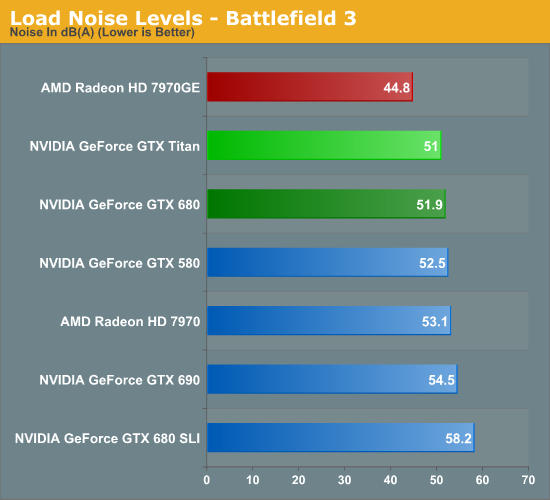
It’s with load noise that we finally see the full payoff of Titan’s build quality. At 51dB it’s only marginally quieter than the GTX 680, but as we recall from our earlier power data, Titan is drawing nearly 70W more than GTX 680 at the wall. In other words, despite the fact that Titan is drawing significantly more power than GTX 680, it’s still as quiet as or quieter than the aforementioned card. This coupled with Titan’s already high performance is Titan’s true power in NVIDIA’s eyes; it’s not just fast, but despite its speed and despite its TDP it’s as quiet as any other blower based card out there, allowing them to get away with things such as Tiki and tri-SLI systems with reasonable noise levels.
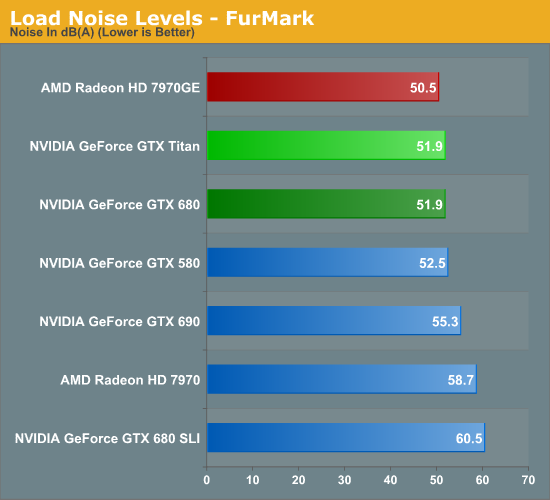
Much like what we saw with temperatures under Furmark, noise under Furmark has our single-GPU cards bunching up. Titan goes up just enough to tie GTX 680 in our pathological scenario, meanwhile our multi-GPU cards start shooting up well past Titan, while the 7970GE jumps up to just shy of Titan. This is a worst case scenario, but it’s a good example of how GPU Boost 2.0’s temperature functionality means that Titan quite literally keeps its cool and thereby keeps its noise in check.
Of course we would be remiss to point out that in all these scenarios the open air cooled 7970GE is still quieter, and in our gaming scenario by actually by quite a bit. Not that Titan is loud, but it doesn’t compare to the 7970GE. Ultimately we get to the age old debate between blowers and open air coolers; open air coolers are generally quieter, but blowers allow for more flexibility with products, and are more lenient with cases with poor airflow.
Ultimately Titan is a blower so that NVIDIA can do concept PCs like Tiki, which is something an open air cooler would never be suitable for. For DIY builders the benefits may not be as pronounced, but this is also why NVIDIA is focusing so heavily on boutique systems where the space difference really matters. Whereas realistically speaking, AMD’s best blower-capable card is the vanilla 7970, a less power hungry but also much less powerful card.










337 Comments
View All Comments
CeriseCogburn - Saturday, February 23, 2013 - link
Here you are arac, some places can do things this place claims it cannot.See the massive spanking amd suffers.
http://www.bit-tech.net/hardware/2013/02/21/nvidia...
That's beyond a 40% lead for the nvidia Titan above and beyond the amd flagship. LOL
No problem. No cpu limited crap. I guess some places know how to test.
TITAN 110 min 156 max
7970ghz 72 min 94 max
TheJian - Sunday, February 24, 2013 - link
Jeez, I wish I had read your post before digging up my links. Yours is worse than mine making my point on skyrim even more valid.In your link the GTX670 takes out the 7970ghz even at 2560x1200. I thought all these dumb NV cards were bandwidth limited ;) Clear separation on all cards in this "cpu limited" benchmark on ALL resolutions.
Hold on let me wrap my head around this...So with your site, and my 3 links to skyrim benchmarks in my posts (one of them right here at anandtech telling how to add gfx, their 7970ghz article), 3/4 of them showing separations according to their GPU class...Doesn't that mean they are NOT cpu bound? Am I missing something here? :) Are you wondering if Ryan benched skyrim with the hi-res pack after it came out, found it got smacked around by NV and dropped it? I mean he's claiming he tested it right above your post and found skyrim cpu limited. Is he claiming he didn't think adding a HI-RES PACK that's official would NOT add graphical slowdowns? This isn't a LOW-RES pack right?
http://www.anandtech.com/show/6025/radeon-hd-7970-...
Isn't that Ryan's article:
"We may have to look at running extra graphics effects (e.g. TrSSAA/AAA) to thin the herd in the future."...Yep I think that's his point. PUT IN THE FREAKIN PACK. Because Skyrim didn't just become worthless as a benchmark as TONS are playing it, unlike Crysis Warhead and Dirt Showdown. Which you can feel free to check the server link I gave, nobody playing Warhead today either. I don't think anyone ever played Showdown to begin with (unlike warhead which actually was fun in circa 2008).
http://www.vgchartz.com/game/23202/crysis-warhead/
Global sales .01mil...That's a decimal point right?
http://www.vgchartz.com/game/70754/dirt-showdown/
It hasn't reached enough sales to post the decimal point. Heck xbox360 only sold 140K units globally. Meanwhile:
http://www.vgchartz.com/game/49111/the-elder-scrol...
2.75million sold (that's not a decimal any more)! Which one should be in the new game suite? Mods and ratings are keeping this game relevant for a long time to come. That's the PC sales ONLY (which is all we're counting here anyway).
http://elderscrolls.wikia.com/wiki/Official_Add-on...
The high-res patch is an OFFICIAL addon. Can't see why it's wrong to benchmark what EVERYONE would download to check out that bought the game, released feb 2012. Heck benchmark dawnguard or something. It came Aug 2012. I'm pretty sure it's still selling and being played. PCper, techpowerup, anandtech's review of the 7970ghz and now this bit-tech.net site. Skyrim's not worth benching but all 4 links show what to do (up the gfx!) and results come through fine and 3 sites show NV winning (your site of course the one of the four that ignores the game - hmm, sort of shows my bias comment doesn't it?). No cpu limit at 3 other sites who installed the OFFICIAL pack I guess, but you can't be bothered to test a HI-RES pack that surely stresses a gpu harder than without? What are we supposed to believe here?
Looks like you may have a point Cerise.
Thanks for the link BTW:
http://www.bit-tech.net/hardware/2013/02/21/nvidia...
You can consider witcher 2 added as a 15th benchmarkable game you left out Ryan. Just wish they'd turn on ubersampling. As mins are ~55 for titan here even at 2560x1600. Clearly with it on this would be a NON cpu limited game too (it isn't cpu limited even off). Please refrain from benchmarking games with less than a 100K units in sales. By definition that means nobody is playing them OR buying them right? And further we can extrapolate that nobody cares about their performance. Can anyone explain why skyrim with hires (and an addon that came after) is excluded but TWO games with basically ZERO sales are in here as important games that will be hanging with us for a few years?
CeriseCogburn - Tuesday, February 26, 2013 - link
Yes, appreciate it thanks, and your links I'll be checking out now.They already floated the poster vote article for the new game bench lineup, and what was settled upon already was Never Settle heavily flavored, so don't expect anything but the same or worse here.
That's how it goes and there's a lot of pressure and PC populism and that great 2 week yearly vacation, and certainly attempting to prop a dying amd ship that "enables" this whole branch of competition for review sites is certainly not ignored. A hand up, a hand out, give em hand !
lol
Did you see where Wiz there at TPU in Titan review mentioned nVidia SLI plays 18 of 19 in house game tests and amd CF fails on 6 of them... currently fails on 6 of 19.
" NVIDIA has done a very good job here in the past, and out of the 19 games in our test suite, SLI only fails in F1 2012. Compare that to 6 out of 19 failed titles with AMD CrossFire. "
http://www.techpowerup.com/reviews/NVIDIA/GeForce_...
So the amd fanboys have a real problem recommending 79xx rather 7xxx or 6xxx doubled or tripled up as an alternative with equal or better cost and "some performance wins" when THIRTY THREE PERCENT OF THE TIME AMD CF FAILS.
I'm sorry, I was supposed to lie about that and claim all of amd's driver issues are behind it and it's all equal and amd used to have problems and blah blah blah the green troll company has driver issues too and blah blah blah...
CeriseCogburn - Tuesday, February 26, 2013 - link
Oh man, investigative reporting....lol" http://www.vgchartz.com/game/23202/crysis-warhead/
Global sales .01mil...That's a decimal point right?
http://www.vgchartz.com/game/70754/dirt-showdown/
It hasn't reached enough sales to post the decimal point. Heck xbox360 only sold 140K units globally. Meanwhile:
http://www.vgchartz.com/game/49111/the-elder-scrol...
2.75million sold (that's not a decimal any more)! Which one should be in the new game suite? "
Well it's just a mad, mad, amd world ain't it.
You have a MASSIVE point there.
Excellent link, that's a bookmark.
Zingam - Thursday, February 21, 2013 - link
GeForce Titan "That means 1/3 FP32 performance, or roughly 1.3TFLOPS"Playstation 4 "High-end PC GPU (also built by AMD), delivering 1.84TFLOPS of performance"
Can somebody explain to me how that above could be? GeForce Titan $999 graphics card has much lesser performance than what would be in basically (if I understand properly) an APU by AMD for $500 for the full system??? I doubt that Sony will accept $1000 or more loss but what I find even more doubtful that an APU could have that much performance.
Please, somebody clarify!
chizow - Thursday, February 21, 2013 - link
1/3 FP32 is double-precision FP64 throughput for Titanic. The PS4 must be quoting single-precision FP32 throughput and 1.84TFlops is nothing impressive in that regard. I believe GT200/RV670 were producing numbers in that range for single-precision FLOPs.Blazorthon - Thursday, February 21, 2013 - link
You are correct about PS4 quoting single precision and such, but I'm sure that you're wrong about GT200 being anywhere near 1.8TFLOPS in single precision. That number is right around the Radeon 7850.chizow - Saturday, February 23, 2013 - link
GT200 was around 1TFlop, I was confused because the same gen cards (RV670) were in the 1.2-1.3TFLOP range due to AMD's somewhat overstated VLIW5 theoretical peak numbers. Cypress for example was ~2.5TFlops so I wasn't too far off the mark in quoted TFLOPs.But yes if PS4 is GCN the performance would be closer to a 7850 in an apples to apples comparison.
frogger4 - Thursday, February 21, 2013 - link
Yep, the quoted number for the PS4 is the single precision performance. It's just over the single precision FP for the HD7850 at 1.76flops, and it has one more compute unit, so that makes sense. The double precision for Pitcairn GPUs is 1/16th of that.The single precision performance for the Titan is (more than) three times the 1.3Tflop double precision number. Hope that clears it up!
StealthGhost - Thursday, February 21, 2013 - link
Why are the settings/resolution used for, at least Battlefield 3, not consistent with those used in previous tests on GPUs, most directly those in Bench? Makes it harder to compare.Bench is such a great tool, it should be constantly updated and completely relevant, not discarded like it seems to be with these tests.